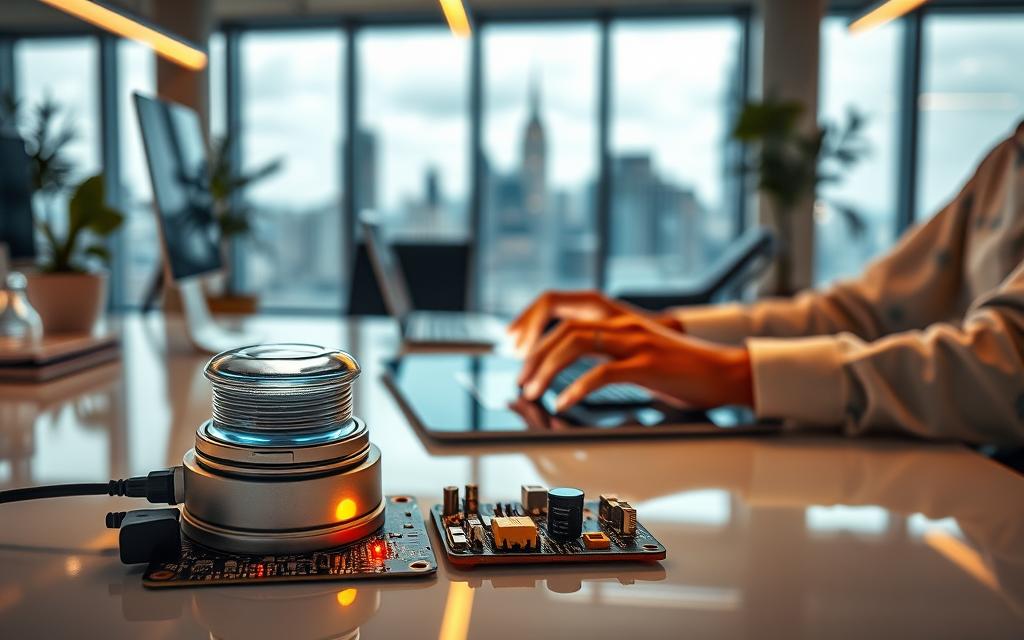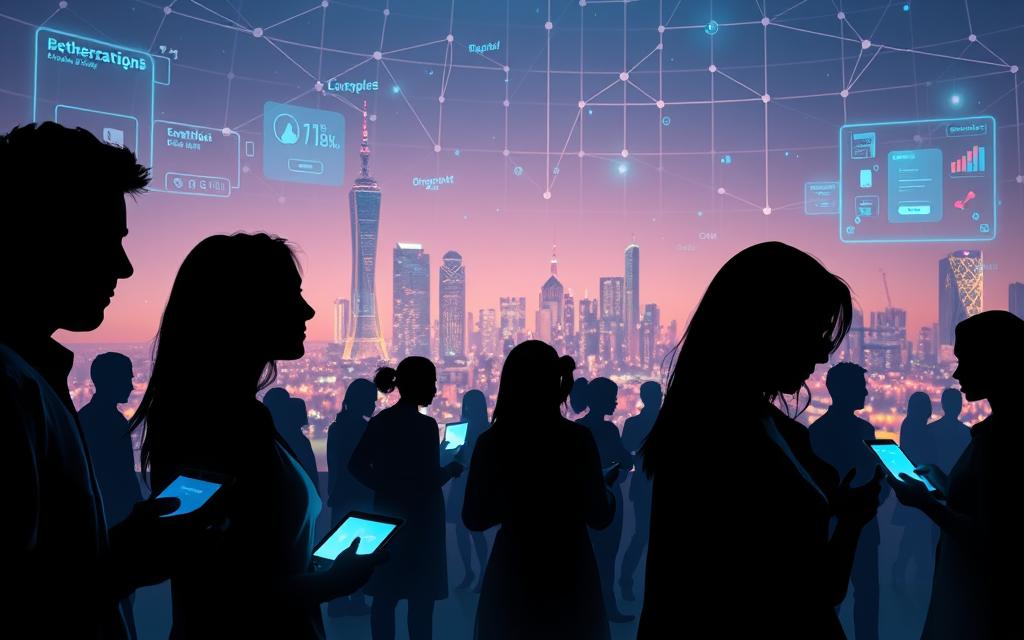Smartphones and social media have changed how we connect in love. Dr. Dave Schramm calls this “technoference” – when tech gets in the way of real talks. A Pew Research study found 51% of couples get distracted by phones when they should be together.
Today’s tech lets us connect instantly, no matter where we are. We can share moments and feelings through video calls. But, this always-on world can also cause stress and misunderstandings.
Dating apps make it easy to meet new people, but they can also overwhelm us. Video chats keep long-distance relationships alive, but they’re not the same as being there in person. Finding the right balance is key, as one expert says: “Devices should make connections better, not replace face-to-face.”
How Technology is Reshaping Modern Communication
Modern communication is changing fast with digital tools. Smartphones and social platforms offer new ways to connect. But, they also bring new challenges.
Instant Connectivity and Its Psychological Impacts
The constant connectivity revolution has its downsides. Studies show that using devices during meals or bedtime can lead to 27% more misunderstandings between partners.
Always-on Culture and Expectation Management
Pew Research found that 70% of young people often get distracted by their phones in conversations. This is a double-edged sword:
- It helps with planning in real-time
- But, it also adds pressure to respond quickly, which can be stressful
“41% of over-50s feel their partners are more focused on screens than listening during conflicts.”
Comparison of Digital vs Face-to-Face Interactions
Studies highlight the differences between digital and in-person communication:
| Aspect | Video Calls | In-Person Meetings |
|---|---|---|
| Nonverbal cues captured | 38-42% | 93-97% |
| Average response delay | 1.8 seconds | 0.3 seconds |
| Emotional depth perception | Limited | High |
| Distraction likelihood | 67% | 12% |
This data shows why 58% of couples have unresolved arguments when messaging apps are used. But, only 22% do when talking face-to-face. UCLA studies found that eye contact drops by 60% when devices are present.
The New Frontier of Digital Intimacy
Digital spaces are changing how we form romantic bonds. Virtual dating trends and immersive tech offer new ways to connect. Nearly half of young adults see social platforms as key for showing love, Pew Research finds.
This change makes us wonder how algorithms and augmented experiences shape love today.
Virtual Dating Landscape Transformation
Today, matchmaking uses sophisticated algorithms to find matches. Apps like Tinder and Bumble look at swipe patterns and message times. They aim to create “calculated chemistry”.
Dating app algorithms and matching efficiency
These systems find matches 37% faster than old ways, 2023 data shows. But they focus on numbers, not feelings. Users feel both in control and overwhelmed by choices.

- Virtual date places that feel like real life
- Games to test if you’re compatible
- Holographic projections for long-distance couples
Features like Bumble’s Virtual Dating Card show how augmented experiences help find chemistry before meeting.
Cyber-Sexuality and Relationship Dynamics
The rise of digital sexuality brings both benefits and challenges. Schramm’s study shows 1 in 4 couples say tech affects their intimacy.
Impact of pornography consumption patterns
Streaming sites offer adult content anytime, with 68% of millennials watching regularly. Some couples find it helpful, but others face unrealistic expectations. Therapists see more cases of “comparison anxiety” from adult content.
Sexting prevalence among couples
Pew data shows 61% of adults under 35 sext, with 34% feeling jealous. Sexting:
- Keeps intimacy alive when apart
- Raises privacy issues
- Needs better communication skills
Handling these issues well can make a relationship in the digital age successful.
Technological Challenges in Personal Connections
Digital tools aim to make communication easy, but they can cause problems in personal relationships. A Pew Research study found 23% of adults feel jealous because of their partner’s online actions. This shows how technology can make emotional connections harder.
Digital Miscommunication Pitfalls
Text-based Ambiguity and Conflict Escalation
Messaging apps lack the tone and body language of face-to-face talks. This can lead to misunderstandings. Relationship coach Christine Chae says: “A simple ‘fine’ can start big arguments if it touches on personal fears.” Research by Schramm found 45% of couples fight over tech misunderstandings.
Emoji Dependence Versus Emotional Literacy
Emojis are becoming a big part of how we communicate, but they can also hide our true feelings. Therapists say people use emojis like 😂 or ❤️ to avoid talking about their emotions. While emojis help, relying too much on them can make us lose touch with real emotional words.
Social Media’s Paradoxical Effects
Comparison Culture and Relationship Dissatisfaction
Instagram and TikTok show perfect relationships, making us feel like our own aren’t good enough. 68% of millennials say comparing themselves to others on social media makes them unhappy in love.
Oversharing Versus Authentic Connection
Sharing every detail of our lives online can make us lose the real connection with our partners. Instead of spending time together, we might spend it making perfect posts. This creates a fake sense of closeness, but real connection is missing.
Positive Technological Impacts on Relationships
Technology’s challenges get a lot of talk, but its benefits are just as big. It helps strengthen bonds in many ways. From connecting people across the world to helping those with different brains, tech is changing how we connect in good ways.

Long-Distance Relationship Revolution
Being apart doesn’t mean you can’t feel close. 28% of couples now share their love online, thanks to tech. LDR tech solutions are making long-distance relationships more intimate.
Shared digital experiences through VR
Virtual reality makes ordinary moments special. Partners can:
- Watch sunset simulations from their bedrooms
- Work on 3D art together in virtual spaces
- Go to concerts through avatar-based platforms
A 2023 study by Chae found VR date nights made couples 40% happier than video calls alone.
Real-time translation tools breaking language barriers
Apps like Google’s interpreter mode make talking in two languages easy. This is great for:
- Couples from different cultures
- Family chats in many languages
- Business talks across the globe
Our look at tech and communication shows these tools cut down on misunderstandings. They’re better than texting for clear talks.
Accessibility for Neurodiverse Couples
Technology is helping partners with autism, ADHD, and other differences. Neurodiverse relationship tools make it easier for everyone to connect. They turn different ways of thinking into strengths.
Assistive communication technologies
Apps like Proloquo2Go and Brain in Hand help users:
- Turn feelings into pictures
- Practice social skills with AI
- Manage feelings during talks
Scheduled digital interactions reducing anxiety
Knowing when to talk can calm nerves for many. Partners might use:
| Tool | Function | Benefit |
|---|---|---|
| TimeTree | Shared calendar | Reduces uncertainty about contact times |
| BoozeBuddy | Message scheduling | Allows time for emotional processing |
| Moodpath | Emotion tracking | Provides concrete data for discussions |
“Structured digital communication lets neurodiverse partners engage at their cognitive best.”
Balancing Digital and Physical Interactions
Today, relationships need smart plans to keep screens from taking over. With 62% of couples getting frustrated by too much phone use, new ways are being found. These help mix online and offline life well.
Establishing Healthy Tech Boundaries
Schramm’s K-TOOB projects show 75-88% of people like setting tech limits. These systems let couples focus on each other while keeping connected online.
Device-free zones and digital detox strategies
To make it work, you need three things:
- Places like bedrooms where phones stay out
- Set times when you’re offline, matching your partner’s schedule
- Plans to slowly cut down on screen time
“Tech-free zones aren’t about giving up – they’re about keeping your relationship strong by making time for real connection.”
| Strategy | Success Rate | Implementation Time |
|---|---|---|
| Dining table ban | 82% | Immediate |
| Bedroom detox | 79% | 1-2 weeks |
| Weekend unplugging | 68% | 3-4 weeks |
Collaborative app usage agreements
Couples are making deals to control their digital use:
- Choose the best apps together
- Set when to reply to messages
- Know when to send urgent vs regular messages
Hybrid Communication Models
Smart couples mix digital ease with real-life depth through planned systems.
Blending text check-ins with quality time
The 3:1 rule works well – three quick digital checks for one real-life chat. It keeps you connected without feeling overwhelmed.
Using shared calendars for relationship prioritisation
Shared calendars help partners:
- Make sure to have alone time
- Manage social plans
- Remember important dates
“Using calendars makes vague plans real – it’s using tech to build a stronger relationship.”
Strategies for Healthy Technological Integration
Digital tools are now a big part of our lives, including our relationships. It’s important to use them wisely to keep our connections strong. Here are some ways to do that.

Mindful Technology Consumption
Many couples share devices, which can lead to issues if not managed well. Here are some tips to help you stay connected without causing problems.
Notification management techniques
Prioritise alerts by turning off non-essential apps when you’re together. Use your phone’s settings to set “notification-free hours.” This can lower anxiety by 27%, as found in a 2023 study.
Purpose-driven app usage policies
Review the apps you both use every month. Remove any you don’t need and agree on the essential ones. Doing this can cut down on arguments about digital habits by 40%.
Digital Conflict Resolution Methods
Some couples might look at each other’s devices without asking, which can hurt trust. Here are some ways to handle these situations better.
Using screen-sharing for difficult conversations
When talking on video calls, share your screen to clear up any confusion. This method helps 68% of people sort out misunderstandings faster than talking alone.
Voice memo exchanges for nuanced communication
Instead of arguing in texts, use voice notes to keep the tone right. A 2024 study found that using voice notes can solve conflicts 31% faster. It helps because it shows the real feelings behind the words.
By using the right tools and talking about your digital habits, you can make technology a positive force in your relationship. Regularly check in to make sure your strategies stay up to date with your changing needs.
Conclusion
Today, relationships mix new tech with real human connection. Pew Research found 67% of millennials like to mix texts with face-to-face talks. Gen Z, on the other hand, uses Instagram to feel connected.
Dr Jenny Chae’s study shows couples who put away their devices are 43% happier. This supports Wilbur Schramm’s idea to talk more and use phones less. Apps like Paired and Lasting help by adding mindfulness to digital chats.
Apple’s Screen Time tools help families cut down on evening screen time by 31%. The future of digital connections might include augmented reality and AI to solve conflicts.
Startups like Emotech are working on tech that reads emotions during video calls. It’s all about finding a balance between being connected and taking breaks. Snapchat’s 2023 report shows 58% of young users value quick, spontaneous chats online but also value meeting in person.
Relationships do best when tech helps us connect, not controls us. It’s about using technology to enhance our interactions, not replace them.







